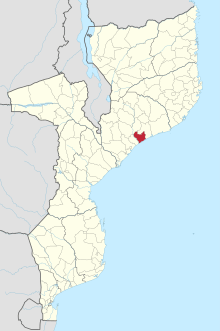Maganja da Costa District
Maganja da Costa District is a district of Zambezia Province in Mozambique.

The name probably derives from that of the Mang'anja people, now mainly resident in southern Malawi. However, from the 17th century onwards, Portuguese explorers used the name Manganja as a territorial designation, and called the people living in that area Maganjas. The original area occupied by the Mang'anja, and the area called Manganja, extended south and east of the area this people currently occupy, and the name of the town Maganja da Costa ("Maganja of the Coast"), about 20 kilometres inland from the Indian Ocean near Pebane records their former eastern extent. At present, the area does not contain any Mang'anja people, but in 1960 the oldest inhabitants recalled that a few survivors of the original population still spoke the Mang'anja language and used to visit rain shrine of M'Bona in southern Nyasaland, a cult exclusive to Mang'anja people.[1]
In the 19th century, the Maganja da Costa district became the stronghold of one of the major Afro-Portuguese families of Mozambique, the Alves da Silva family. Its founder, António Alves da Silva, came from the province of Beira in Portugal in the early 19th century and established a trade in ivory and slaves. His two sons, João Bonifacio and Victorino Romão, became prominent slave traders operating in the Luangwa and Lower Shire valleys and, as they were unable to use the port of Quelimane after the banning of the legal slave trade in 1830, they built a number of fortified villages called “aringas”, consisting of a wooden stockade and earthworks in the form of a ditch and bank in the district.[2] The aringas were manned by about a dozen chikunda bands of armed retainers, initially each of around 250 men, under its own captain. The largest da Silva aringa in the Maganja da Costa district was known as M'Passue after the African title used by the head of the family, and it was said to be the largest aringa ever built in Mozambique.[3].
João Bonifacio was killed in 1861 and Victorino Romão died in 1874, ending the direct line of succession from António Alves da Silva. Thereafter, Maganja da Costa evolved into a form of chikuna republic, with effective power devolved to the captains of each aringa, and which the Portuguese military commander, João de Azevedo Coutinho, called the "Military Republic of Maganja da Costa". By the 1890s, the "Military Republic" was in decline as the illicit slave trade had largely been suppressed, although in 1897, de Azevedo Coutinho was able to recruit an armed force from the chikunda of Maganja da Costa to overcome resistance to Portuguese colonial rule in the Zambezi valley. Once resistance in other areas had been suppressed, Maganja da Costa was itself occupied by Portuguese forces in 1898 and its independence was ended.[4].
References
- T. Price, (1960), "The Meaning of Mang'anja", The Nyasaland Journal, Vol. 16, No. 1 p. 75
- M Newitt (1995), "A History of Mozambique", pp. 253-4, 306 London, Hurst & Co. ISBN 1-85065-172-8
- M Newitt (1995), "A History of Mozambique", p. 307
- M Newitt (1995), "A History of Mozambique", pp. 370-1